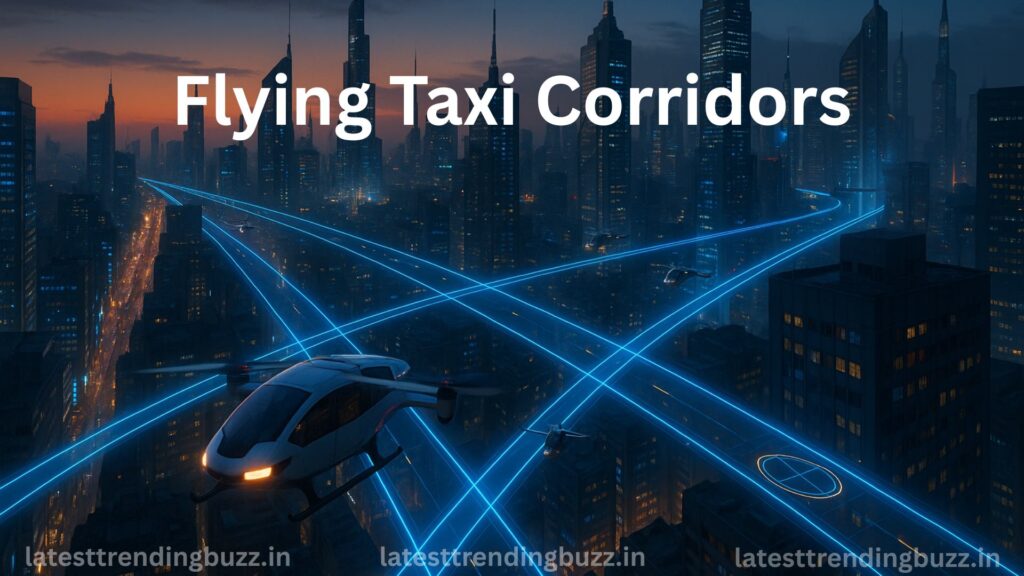If you think traffic jams are bad now, wait till you realize cities are moving traffic into the sky.
Welcome to the future of transport — where Flying Taxi Corridors are being mapped across megacities like Dubai and Tokyo. By 2030, you might hail an air taxi the same way you book an Uber.
Dubai’s desert skyline and Tokyo’s neon labyrinths are becoming testbeds for urban air mobility — a system of aerial highways, vertical takeoff pads, and AI navigation grids that will redefine the daily commute.
Let’s explore how two of the world’s smartest cities are literally taking transportation to new heights.
What Are Flying Taxi Corridors?
Flying Taxi Corridors are pre-mapped aerial routes designed specifically for electric vertical takeoff and landing (eVTOL) vehicles.
Think of them as air roads — invisible sky lanes that connect vertiports (flying taxi stations) across the city. These corridors use advanced air traffic management systems powered by AI to ensure flight safety, prevent collisions, and manage thousands of mini aircrafts simultaneously.
Each corridor is typically between 300 to 600 meters above ground, depending on city airspace regulations.
So, instead of ground traffic lights, there are digital air grids. Instead of parking lots, there are rooftop vertiports.
Dubai — The World’s First Flying Taxi Hub
Dubai isn’t just planning Flying Taxi Corridors — it’s already building them.
In 2025, Dubai will officially launch the world’s first regulated flying taxi routes, operated by Joby Aviation and EHang in partnership with the Dubai Roads and Transport Authority (RTA).
Here’s what Dubai’s network will include:
- Four Main Vertiports: Near Dubai International Airport, Downtown, Palm Jumeirah, and Dubai Marina.
- Sky Corridors: Connecting these zones through AI-managed routes.
- eVTOL Fleet: Quiet, all-electric flying taxis capable of carrying 2–4 passengers.
- Flight Time: 10–15 minutes across zones that currently take 45–60 minutes by road.
Smart Coordination
Each eVTOL operates within geo-fenced digital corridors, monitored by Dubai’s Smart Air Mobility Command Center. The AI system synchronizes flights in real-time to prevent overlap and optimize routes based on air density, weather, and time of day.
Essentially, Dubai is building the sky equivalent of a metro system.
Why Dubai?
Dubai’s terrain and technology-forward governance make it the ideal prototype city for Flying Taxi Corridors:
✅ Flat geography and wide open spaces.
✅ Minimal air congestion compared to other megacities.
✅ Government-led innovation through “Dubai Future Foundation.”
✅ Heavy investment in renewable energy and smart infrastructure.
By 2030, Dubai expects to have 25% of its transport system autonomous, including both land and air routes.
And yes — by then, your morning commute might include a five-minute flight from Business Bay to Palm Jumeirah.
Tokyo — The Precision Blueprint of the Sky
While Dubai’s approach is bold and fast, Tokyo’s plan for Flying Taxi Corridors is precise, methodical, and deeply integrated into Japan’s smart city ecosystem.
The Japanese government, through the Ministry of Land, Infrastructure, Transport and Tourism (MLIT), aims to launch flying taxi services by 2026, just in time for the Osaka World Expo — using corridors between airports and expo venues as the first real-world test.
Also Read: Selling Your Thoughts: The Future of Data Economy in 2040
Tokyo’s Air Mobility Vision
- Urban eVTOL Routes: Linking Haneda Airport, central Tokyo, and Odaiba.
- Sky Networks: Layered corridors at different altitudes to separate cargo, emergency, and passenger drones.
- AI Navigation: Using U-space, Japan’s next-gen air traffic system, to coordinate thousands of small aircraft.
- Zero Emission Policy: Every vehicle in these Flying Taxi Corridors must be fully electric or hydrogen-powered.
Japan’s emphasis is on precision and sustainability — where efficiency meets environmental ethics.

The Tech Powering the Corridors
Both Dubai and Tokyo rely on cutting-edge systems to make Flying Taxi Corridors safe and scalable:
1. AI-Based Air Traffic Control
Artificial Intelligence tracks every flying taxi in real time, calculating safe distances and rerouting in case of weather shifts or emergencies.
2. Digital Twins
Cities use digital replicas of their entire airspace to simulate millions of flight patterns before deployment — predicting congestion, wind interference, and energy use.
3. Vertiport Automation
Vertiports use robotics for passenger boarding, charging, and scheduling — ensuring fast turnaround times for high-frequency flights.
4. Geo-Fencing & Lidar Mapping
Each corridor is 3D-mapped with centimeter precision, ensuring no overlap with drone delivery or private aviation zones.
This combination of automation and oversight ensures that flying taxis don’t just fly — they flow.
The Economic Sky Race
Building Flying Taxi Corridors is expensive — but the payoff is enormous.
Analysts estimate the global Urban Air Mobility (UAM) market will exceed $100 billion by 2035. Dubai and Tokyo are leading this race by investing early in regulation, infrastructure, and public trust.
- Dubai’s Investment: $1.5 billion in air mobility over the next 5 years.
- Japan’s Investment: $1 billion across Tokyo, Osaka, and Nagoya for corridor testing.
These cities aren’t just building transport — they’re creating sky economies.
Also Read: When AI Becomes Your Therapist Can Machines Heal Human Minds?
India Watching Closely
India is already observing these developments closely. Cities like Bengaluru and Hyderabad are exploring feasibility studies for Flying Taxi Corridors under the Ministry of Civil Aviation’s “NextGen Mobility” initiative.
Indian aerospace startups are partnering with Japanese and UAE firms to bring eVTOL prototypes for testing by 2028.
With traffic congestion being one of India’s biggest urban challenges, sky corridors could one day become part of Smart City 2.0 projects.
Regulations and Safety
Air taxis can’t just take off anywhere. Both Dubai and Tokyo are creating strict frameworks for:
- Pilotless Flight Certification
- Cybersecurity in Air Traffic Networks
- Noise Pollution Standards
- Passenger Insurance and Data Privacy
The first step of the Flying Taxi Corridors isn’t flight — it’s governance. The goal is to ensure people trust these vehicles enough to step inside them.
The Passenger Experience
So, what will it feel like to travel through Flying Taxi Corridors?
Imagine this:
You step into a sleek eVTOL pod at a vertiport rooftop in downtown Tokyo.
Facial recognition confirms your identity; your seatbelt clicks automatically.
The pod lifts silently into the air, merges with the city’s aerial lane, and soars over skyscrapers.
A 45-minute car ride becomes a 7-minute flight.
You’re not stuck in traffic — you’re gliding above it.
Building the Infrastructure of the Sky
The backbone of Flying Taxi Corridors isn’t just aircraft — it’s vertiports.
Dubai and Tokyo are building multi-level stations with:
- Landing pads
- Fast-charging docks
- Emergency descent zones
- Passenger lounges
- AI-based traffic monitors
Each vertiport acts like an airport, metro station, and power grid combined — designed to handle hundreds of short flights per day.
By 2035, both cities plan to integrate vertiports into malls, office complexes, and airports.
Environmental Benefits
Flying taxis may sound like sci-fi luxuries, but they’re surprisingly green.
Electric eVTOLs produce zero emissions and minimal noise compared to helicopters. Replacing short car trips with air taxis could reduce urban CO₂ levels by up to 20% in major metros.
By integrating Flying Taxi Corridors into sustainable city plans, Dubai and Tokyo are proving that innovation and ecology can co-exist — in the clouds.
The Future of Flying Taxi Corridors
By 2040, expect every major global city to have its own network of Flying Taxi Corridors.
- Dubai: Global showcase of luxury air mobility.
- Tokyo: Benchmark for efficiency and regulation.
- Singapore & Seoul: Already building their own corridor trials.
- India (Next): Likely to adopt hybrid air taxi models for intercity routes.
Airspace will become the new real estate frontier — and cities will compete to claim it.
FAQs
Q1. What are Flying Taxi Corridors?
They are designated air routes for electric vertical takeoff vehicles to ensure safe, organized air mobility.
Q2. When will Dubai launch its first corridor?
Dubai plans to start passenger operations by 2025.
Q3. Will Tokyo have flying taxis by the 2030s?
Yes, Tokyo aims for full-scale operations by 2030 after pilot runs at the Osaka Expo.
Q4. Are Flying Taxi Corridors safe?
Extremely. They use AI-driven air traffic control and real-time monitoring systems.
Q5. Will India build Flying Taxi Corridors?
India is studying the technology and may introduce pilot projects post-2030.
Disclaimer
This article, Flying Taxi Corridors, explores ongoing projects and speculative advancements in urban air mobility. Timelines and outcomes may vary based on technological and regulatory developments.














